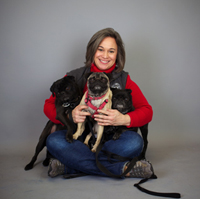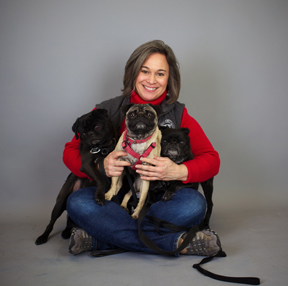
Elisa Mazzaferro 288

Photo courtesy of Dr. Elisa Mazzaferro
Dr. Elisa Mazzaferro, a staff criticalist at Cornell University Veterinary Specialists in Stamford, Connecticut, says euthanizing animals has been the toughest part of her job during the pandemic. She is pictured here with her gaggle of pugs, well before anyone had ever heard of COVID-19.
“Good morning Mr. Smith, my name is Dr. Mazzaferro. I am the criticalist taking over Brownie’s care today. Unfortunately, I’m sorry to say that I don’t have good news. Brownie’s blood pressure further decreased overnight despite the antibiotics and other medications. She is starting to develop fluid under her skin and in her lungs. We have had to place her on oxygen. At this time, we don’t have additional oxygen methods because of COVID-19. Our ventilators have been donated to a human hospital in New York City. My recommendation is to allow us to humanely euthanize her so that she does not suffer.”
Mr. Smith: “Can we come and see her and be with her?”
This is the fourth call that I have made this week, with similar requests and similar responses. Each time I have made this call, it rips at my heart. I feel guilty and callous. I feel inadequate. I feel that I am being insensitive to my clients’ needs.
I became a veterinarian because I love animals, but I find that the majority of my job is counseling humans — about medicine and also how to navigate their emotions in an emergency and for the most critical medical conditions. But I am scared.
I work 40 minutes east of New York City, in the Connecticut county hardest hit by the coronavirus. Information is changing moment to moment. Coworkers are staying home because they have been exposed to an infected friend, neighbor, family member or a coworker exposed by another person at a second job. My staff is scared. We want to be here for the animals. But we want to be at home where it is safe, away from people who can give us the virus. We want to help the animals. We want to help their families. But we are scared.
“I’m sorry Mr. Smith, due to COVID, we are not allowing face-to-face contact at this time. I am so sorry, but we are not allowing visitors.”
Mr. Smith: “But I will wear a mask. I promise I am healthy.”
I am sad. I am reminded that two of my coworkers were exposed to the virus and tested positive but fortunately did not develop any clinical signs of the virus. They were the lucky ones. Three of my other coworkers have lost family to the virus in the past two weeks — an uncle, a mother-in-law and a cousin. Who is next?
I think of how many times during a euthanasia, a client’s tears and nasal secretions have dripped on my hand as I push the plunger of the white, then pink or blue solution, as their pet takes its last breath. I want the animal’s passing to be peaceful, and I am also there to comfort the family member who stays behind. So many times, the family members embrace me as they cry. They need a human to touch, to thank, to lean on. My scientific mind tells me how many virus particles can be in the one drop from a human’s nose. My paranoia and prudence are guiding my judgment. I must say, “no,” but my heart is breaking. This is so different from every euthanasia I have done in the past 20 years. I want Mr. Smith’s last memory of Brownie to be peaceful. I want to say, “yes” to his request to be with her. But I have to take care of my 98-year-old grandmother. I have to be able to stay healthy for her and also for my patients. I am scared.
“At the east side of our building, we have a room that has a floor-to-ceiling window,” I tell Mr. Smith. “I can bring Brownie to that room, and then call you so you can talk to her on speakerphone if you would like, and then when you are ready, I can perform her euthanasia while you are there. You can speak with her through the phone and you will be able to see her through the window.”
The emergency and critical care staff overhears my conversation and looks at me with sad expressions. They have been working with Brownie for the past four days. They have tried their hardest and know that we can’t do anymore. They know that it is time. But they care. They don’t like that this is the ending the family will experience. They, too, are scared.
Reluctantly, Mr. Smith agrees that this will be the best decision for Brownie. Due to the pandemic, he has not seen her in three days. I can see that he is not prepared for the visual of her swollen face and limbs, the patches of medical tape, catheters and nasal tubes, her respiratory distress and the hollow look in her eyes that has shown me we are making the right decision for her.
I wheel Brownie down the corridor to the room at the east side of our building. Mr. Smith is standing on steps in what used to be an entranceway, peering through the floor-to-ceiling glass. The day is overcast, and it has started to drizzle outside. He has brought his wife and what appears to be his 7- or 8-year-old son. I have never met the family until now.
I call his cellphone, and he fumbles with it in his pocket, confused as to who would be calling at this most precious time.
“Hello, Mr. Smith, this is Dr. Mazzaferro. I’m here with Brownie and you are on speakerphone with her.”
Mr. Smith: “Brownie, oh, Brownie. James, talk to Brownie!”
All I hear is crying through the phone as I watch the woman crying, my glasses fogging while I wear my ever-present mask. James, the young boy, is sobbing and asking why he can’t pet her. He turns to his mom, and she hugs him, tears streaming down their masked faces.
Mr. Smith: “Doctor, she is struggling! Please. Please, just do it!”
As I prepare to push the white fluid into Brownie’s vein, Mr. Smith takes his mask off, and wipes his tears and dripping nose with his gloved hand.
Having been an emergency and critical care specialist for more than 20 years, euthanasia is something that is an unfortunate part of my daily life. I am able to sleep at night believing that euthanasia is an unselfish gift and a treatment that we can provide when an animal’s quality of life is suffering or their injuries too severe to easily fix.
I want a family’s last memory of their pet to be as peaceful as possible. I want family members to have the option of being present at the time of their pet’s passing. I want their pet to have the presence of their family in that last moment, even if the animal does not know what is coming next. Among all the changes that we have had to adapt to in our work and outside lives during this pandemic, euthanasia has been the most stressful. I am not used to saying “no.” I am a nurturer. I am a caregiver. I am a friend. But I am scared.
I am sure that I am not alone in my feelings and practices. Together as a profession, I am sure others have struggled with the same feelings. We have to stay safe and stay healthy so that we can continue to take care of the animals. Sometimes that means saying “no” and coming up with an adaptation or a compromise.
My hope is that by staying safe, we will survive in this pandemic and be alive to tell the next generation of caregivers what we had to go through. Hopefully, by then, there will be a vaccine. Hopefully, by then, there will be a cure. We won’t have to lend our medical equipment to help save human lives. We won’t have to isolate in order to keep ourselves and our families healthy. We will stay strong together. We won’t be scared.
About the author: Dr. Elisa Mazzaferro is a graduate of Michigan State University College of Veterinary Medicine. She completed a residency in emergency-critical care at Colorado State University, where she also earned a doctorate in small animal clinical sciences. A staff criticalist for Cornell University Veterinary Specialists in Stamford, Connecticut, Mazzaferro is past president of the American College of Veterinary Emergency & Critical Care and president-elect of the Veterinary Emergency and Critical Care Society. In 2018, she received the Ira Maslow Distinguished Service Award from VECCS. She has authored and edited four books, numerous book chapters and manuscripts on topics relating to emergency and critical care medicine. She lectures extensively and has given presentations in more than 21 U.S. states and nine countries.